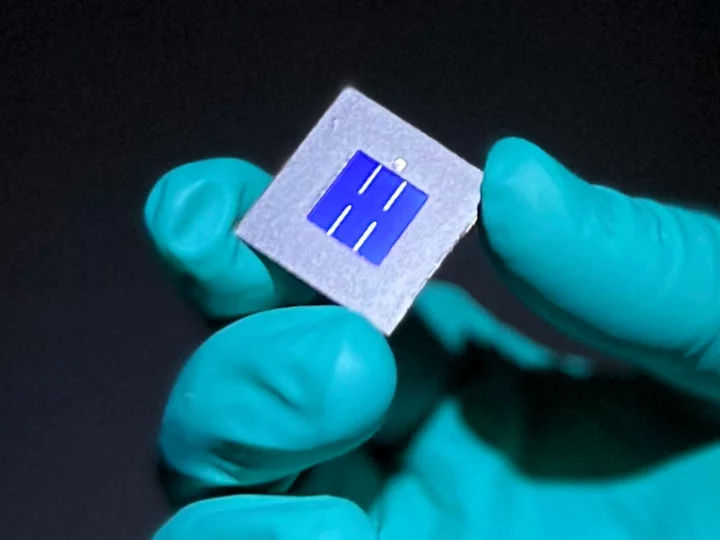
Record-breaking sugar battery could supercharge transition to renewable energy
Scientists have used sugar to create a record-breaking battery capable of storing grid-scale energy for more than a year. The breakthrough could help speed up the transition to renewable energy sources, which require vast amounts of battery storage in order to avoid relying on fossil fuels to meet demand when solar or wind output is low. A team from the US Department of Energy’s Pacific Northwest National Laboratory (PNNL) made the latest discovery while researching flow batteries, which use two liquid-filled chambers to produce an electrochemical reaction to store and release energy. Flow batteries have the potential to be scaled up to the size of football fields, capable of storing vast amounts of energy, however current methods for creating them rely on mined minerals that are difficult and costly to obtain. “This is a brand new approach to developing flow battery electrolyte,” said Wei Wang, a battery researcher who led the investigation into the new method. “We showed that you can use a totally different type of catalyst designed to accelerate energy conversion.” The researchers used a dissolved simple sugar called β-cyclodextrin, which is a derivative of starch, in order to boost their flow battery’s longevity and capacity. The system achieved 60 per cent more peak power than current methods, while also being capable of storing and releasing energy for more than a year continuously. The latest advance makes the next-generation battery design “a candidate for scale up”, according to the researchers. “We cannot always dig the Earth for new materials,” said Imre Gyuk, director of energy storage research at DOE’s Office of Electricity. “We need to develop a sustainable approach with chemicals that we can sythesize in large amounts – just like the pharmaceutical and the food industries.” A study detailing the research, titled ‘Proton-regulated alcohol oxidation for high-capacity ketone-based flow battery anolyte’, was published in the scientific journal Joule. Read More How tech could turn our homes into renewable energy power stations ‘Miracle material’ smashes solar panel efficiency threshold Mineral discovery could meet global battery and solar panel demand for next 100 years Why the Battle of the Boyne has made its way into your iPhone Twitter gets strange endorsement from Taliban over rival Threads
2023-07-11 18:53

AI Trading Is Playing a Growing Role in Europe’s Power Bills
A Danish energy trader crunches about 30 million data points every day in an effort to predict how
2023-07-11 12:18

10 of the Best Early Prime Day Deals You Can Score on Apple Products
Shop massive discounts on iPads, AirPods, Apple Watches, and more with these Apple Prime Day deals.
2023-07-11 06:18

Scientists make surprising discovery that could help boost the global population
Infertility is a problem that afflicts more than a billion people across the world, which is why treatments such as IVF are so important. The procedure (in vitro fertilisation, to use it’s full name) involves the extraction of an egg from the woman's ovaries to be fertilised with sperm in a laboratory and returned to the woman’s womb. The goal is that the resulting embryo will then grow and develop into a foetus, blessing the parent or parents with a baby. However, success rates for IVF – as in, the percentage of treatments that result in a live birth – remain somewhat unencouraging: 32 per cent for women aged under 35; 25 per cent for women aged 35 to 37, with the numbers continuing to drop the older you get, according to the NHS. Nevertheless, a major new study has revealed a striking new finding which could help boost the hopes of countless aspiring mums and dads across the world. Sign up for our free Indy100 weekly newsletter After analysing 3,657 frozen embryos over a period of eight years, researchers in Western Australia found that IVF was much more likely to work when eggs had been harvested in the summer. The team clarified that it didn’t seem to matter when the embryos were transferred to the mother’s womb, just when the eggs were collected. Indeed, the likelihood of babies being born when the eggs had been retrieved in the summer was 30 per cent higher than when they had been retrieved in the autumn, according to the scientists. The team also found that the temperature on the day of egg collection didn’t seem to have an impact on success rates, but the number of sunny hours did. Of the embryos they tested, those harvested on days that had the most sunshine were 28 per cent more likely to result in a live birth compared to the darkest and most overcast days. “Our study suggests that the best conditions for live births appear to be associated with summer and increased sunshine hours on the day of egg retrieval,” the study’s lead, Dr Sebastian Leathersich, of Perth’s King Edward Memorial Hospital, said about the paper, which was published in the journal Human Reproduction. Still, he noted: “There are many factors that influence fertility treatment success, age being among the most important. “However, this study adds further weight to the importance of environmental factors and their influence on egg quality and embryonic development." He further explained: “We effectively separated the conditions at the time of egg collection from the conditions at the time of transfer, demonstrating that environmental factors when the eggs are developing are as, if not more, important than environmental factors during implantation and early pregnancy.” The expert obstetrician and gynaecologist added: “Optimising factors such as avoiding smoking, alcohol and other toxins and maintaining healthy activity levels and weight should be paramount. However, clinicians and patients could also consider external factors such as environmental conditions.” Despite Dr Leathersich and his colleagues concluding that the temperature on the day of egg collection had little bearing on the success of the process, they also found that the temperature on the day of embryo implantation did make a difference. The chances of a live birth rate decreased by 18 per cent when the embryos were transferred on the hottest days (when average temperatures measured between 14.5C and 27.8C) compared to the coolest days (0.1C to 9.8C), and there was a small increase in miscarriage rates, from 5.5 per cent to 7.6. The finding that miscarriage rates were highest when embryo transfer took place on the hottest days is consistent with other studies showing higher rates of miscarriage in the summer months. “This suggests that the negative effects of high temperature are more likely related to early pregnancy rather than egg development,” Dr Leathersich concluded. When it comes to the disparity in success rates between eggs retrieved in summer and autumn, he and his team pointed out that melatonin levels could be at play. Differences in lifestyles between the winter and summer months may also play a role, he and his colleagues acknowledged. "It is possible that there are differences in activity, diet, and lifestyle in different seasons which could underlie the observed differences in live birth rates, though such data were not collected in this study," they wrote. "It is also possible that other environmental factors, including pollutants, may impact clinical outcomes." Whilst the study’s findings are compelling, Dr Leathersich and his team admitted that it did have its limitations. The research was done in hindsight, using eggs that had been frozen, then thawed, so it could not draw watertight conclusions. “Ideally, these findings should be replicated in other sites with different conditions and different treatment protocols to confirm the findings,” Dr Leathersich said. “It would also be interesting to look at the impact of season and environmental factors on sperm parameters, as this could have contributed to our observations.” He added: “We are now planning to analyse this same group of patients using air quality data, as there may be seasonal changes in exposure to harmful pollutants which could negatively affect reproductive outcomes. “Finally, given the huge increase in so-called 'social egg freezing' for fertility preservation and the fact that this group generally have flexibility about when they choose to undergo treatment, it would be very interesting to see if these observations hold true with frozen eggs that are thawed and fertilised years later. “Any improved outcomes in this group could have big impacts for women making decisions about their future fertility, but the long-term follow-up required means it is likely to be some time before we can draw any conclusions for this population.” Have your say in our news democracy. Click the upvote icon at the top of the page to help raise this article through the indy100 rankings.
2023-07-10 23:22

Instagram Threads hits 100 million users, becoming easily the fastest growing app ever
Instagram’s Threads app has reached 100 million users, making it easily the fastest growing app ever. The site reached the number early on Monday morning, according to a tracker that looks at the numbers that are made public on each Threads account.
2023-07-10 15:59

How the Food System Is Changing and What It Means for Investors
Global shifts in incomes and populations, geopolitics and climate change are combining to drastically alter the outlook for
2023-07-09 14:23

New US Pregnancy Laws Aren’t Enough for a Family-Friendly Workplace
New rules for US employers will make it easier for many pregnant workers to keep doing their jobs,
2023-07-07 17:27

‘Miracle material’ smashes solar panel efficiency threshold
Scientists have achieved a major breakthrough using a so-called ‘miracle material’ to boost the efficiency of solar panels. Two separate studies published on Thursday demonstrated how the material perovskite could push the power conversion efficiency rate of photovoltaic (PV) solar cells above 30 per cent – beyond the theoretical limit of 29 per cent for traditional silicon (PV) solar cells. “Overcoming this threshold provides confidence that high-performance, low-cost PVs can be brought to the market,” wrote material science researchers Stefaan de Wolf and Erkan Aydin, who were not involved in the research, in an article published in the journal Science. Perovskite has emerged in the past 15 years as a material capable of transforming an array of industries, from renewable energy, to ultra high-speed communications. Materials science professor Zeev Valy Vardeny from the University of Utah described perovskite in 2017 as “unbelievable, a miracle material”, after it was able to radically improve the sunlight-to-energy efficiency of solar cells. Perovskite’s properties allow it to harvest energy from a greater range of the light spectrum, however until recently it was too unstable to be used outside of laboratory conditions. By stacking a layer of perovskite on top of silicon into a tandem device, the researchers were able to significantly boost the efficiency of commercial PV technologies while retaining the industry standard configuration. “Tandem solar cells are the most straight-forward route toward decreasing the levelized cost of electricity, well beyond what is possible for single-junction solar cells,” wrote Professor de Wolf and Aydin. The teams from China and Japan who were behind the latest breakthrough claim the latest design will pave the way for the mass production of ultra-efficient solar panels. The current efficiency record for this next-generation solar cell is 33.7 per cent, achieved by engineers at the KAUST Solar Center in Saudi Arabia earlier this year, having risen from under 4 per cent efficiency in 2009. Last month, a startup in China announced that it planned to begin production of tandem solar cells, with the abundance of perovskite cutting costs to “just one 20th of traditional solar cells”, according to Professor Tan Hairen from Nanjing University. The scientists behind the latest research believe their approach could ultimately achieve an efficiency rate “well above 35 per cent”, though more work needs to be done on making the tandem cells more durable in real-world conditions, as well as scaling them up to the size of traditional solar panels. “Arguably, the most critical factor lies in the annual degradation rate under actual outdoor conditions, which for perovskite-silicon tandems remains largely unknown,” the Perspective noted. “To be commercially viable, this degradation should be on par with mainstream PV technologies, which is less than 1 per cent relative per year.” The research was detailed in two separate papers published in the journal Science. Read More Massive mineral deposit discovery could meet global battery and solar panel demand ‘for next 100 years’
2023-07-07 03:29

Scientists capture the moment a black hole 'turns on'
Astronomers have spotted the moment a black hole "turned on". While looking for the collision of a neutron star with another object, which should result in a kilonova (an explosion which reddens then fades over time), they stumbled upon an event which remained extremely bright. They soon worked out this light was because of supermassive black hole called J221951-484240 which had been on for around 10 months. But then they had to work out what had caused it, and got stuck between two causes, “J221951 is consistent with being nuclear, so the scenarios we are being left are a tidal disruption event or an active galactic nucleus,” lead author Dr Samantha Oates said as she presented the research at the National Astronomy Meeting 2023. “Looking at the spectrum it's consistent with both categories.” Sign up to our free Indy100 weekly newsletter A tidal disruption event (TDE) takes place when a star or a gas cloud gets too close to a supermassive black hole. The material is ripped apart, and begins to shine as the black hole feeds Alternatively, it could be an active galactic nucleus (AGN), the phase of a supermassive black hole where it is consistently feeding in a frenzy. “We hope in future to distinguish between these two scenarios,” Dr Oates concluded. Have your say in our news democracy. Click the upvote icon at the top of the page to help raise this article through the indy100 rankings.
2023-07-06 20:16

Musk Lauds China’s AI Prowess While Warning of Tech’s Dangers
Tesla Inc. chief executive Elon Musk reaffirmed his vision of a robot-fueled future, calling for more regulatory oversight
2023-07-06 11:23

Scientists discover life living deep beneath the ocean floor
The secret to life on distant planets could lie beneath the ocean floor, according to staggering research. A rich tapestry of microbes uncovered from rocks hundreds of feet down among the ocean crust proved an illuminating discovery for authors of a study first published in 2020. The single-cell organisms that live off methane in the South Pacific were far more plentiful in number than expected after being uncovered during an expedition in 2010. It came when the Integrated Ocean Drilling Program (IODP) collected samples from 400 feet below the ocean crust. Sign up to our free Indy100 weekly newsletter The sheer number of microbes they found in the rock samples surprised them, with the rocks containing an enormous 10 billion bacterial cells – a huge increase compared to normal levels on the seafloor, which normally only measure around 100 bacterial cells per cubic centimeter. "I thought it was a dream, seeing such rich microbial life in rocks," Yohey Suzuki from the University of Tokyo said. The signs are certainly encouraging when it comes to searching for life on Mars and other planets in the solar system, especially as the findings of the study suggested that the microbes were there organically and not influenced by underwater volcanoes. "Minerals are like a fingerprint for what conditions were present when the clay formed. Neutral to slightly alkaline levels, low temperature, moderate salinity, iron-rich environment, basalt rock—all of these conditions are shared between the deep ocean and the surface of Mars," Suzuki said. Have your say in our news democracy. Click the upvote icon at the top of the page to help raise this article through the indy100 rankings.
2023-07-05 18:53

Supermoon completely dwarfs plane as it flies through Oregon skies in spectacular clip
July's Buck supermoon could be seen around the world lighting up the skies at the start of this week, but incredible new footage is showing the sheer scale of the phenomenon. A plane flying over the skies of Oregon is going viral after being filmed getting completely eclipsed by the moment. In the footage of the giant moon, the tiny plane goes flying past, and looks absolutely minuscule in comparison to the planet. Click here to sign up for our newsletters
2023-07-05 17:55
